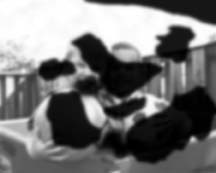Diabetic retinopathy history and symptoms: Difference between revisions
No edit summary |
No edit summary |
||
| Line 8: | Line 8: | ||
==Overview== | ==Overview== | ||
<gallery> | <gallery> | ||
Image:Human eyesight two children and ball normal vision.jpg|Normal vision. Courtesy [[National Institutes of Health|NIH]] [[National Eye Institute]] | Image:Human eyesight two children and ball normal vision.jpg|Normal vision. Courtesy [[National Institutes of Health|NIH]] [[National Eye Institute]] | ||
Image:Human eyesight two children and ball with diabetic retinopathy.jpg|The same view with diabetic retinopathy. | Image:Human eyesight two children and ball with diabetic retinopathy.jpg|The same view with diabetic retinopathy. | ||
</gallery> | </gallery> | ||
Early diabetic retinopathy does not have any symptoms. With the | Early diabetic retinopathy often does not have any symptoms. With further progression of the disease, patients may notice one or more of the following symptoms: | ||
*[[Bleeding]] | *[[Bleeding]] | ||
*Blurred vision and gradual [[vision loss]], and even [[blindness]]. | *Blurred vision and gradual [[vision loss]], and even [[blindness]]. | ||
*[[Floaters]] | *[[Floaters]] which are dark spots in the field of vision. | ||
*Shadows or missing areas of vision | *Shadows or missing areas of vision | ||
*Difficulty seeing at nighttime | *Difficulty seeing at nighttime | ||
*Primary detachment of retina can present with similar symptoms. | *Primary detachment of retina can present with similar symptoms. | ||
As new blood vessels form at the back of the eye as a part of ''proliferative diabetic retinopathy'' (PDR), they can bleed ([[haemorrhage]]) and blur vision. | As new blood vessels form at the back of the eye as a part of ''proliferative diabetic retinopathy'' (PDR), they can bleed ([[haemorrhage]]) and blur vision. The first time this happens, it may not be very severe. | ||
The first time this happens, it may not be very severe. | |||
In most cases, it will leave just a few specks of [[blood]], or spots, floating in a person's visual field, though the spots often go away after a few hours. | In most cases, it will leave just a few specks of [[blood]], or spots, floating in a person's visual field, though the spots often go away after a few hours. | ||
These spots are often followed within a few days or weeks by a much greater leakage of blood, which blurs vision. | These spots are often followed within a few days or weeks by a much greater leakage of blood, which blurs vision. In extreme cases, a person will only be able to tell light from dark in that eye. | ||
In extreme cases, a person will only be able to tell light from dark in that eye. | It may take the blood anywhere from a few days to months or even years to clear from the inside of the eye, and in some cases the blood will not clear. These types of large hemorrhages tend to happen more than once, often during [[sleep]]. | ||
It may take the blood anywhere from a few days to months or even years to clear from the inside of the eye, and in some cases the blood will not clear. | |||
These types of large hemorrhages tend to happen more than once, often during [[sleep]]. | |||
==External links== | ==External links== | ||
Revision as of 14:37, 17 September 2011
For patient information click here
|
Diabetic retinopathy Microchapters |
|
Diagnosis |
|---|
|
Treatment |
|
Case Studies |
|
Diabetic retinopathy history and symptoms On the Web |
|
American Roentgen Ray Society Images of Diabetic retinopathy history and symptoms |
|
Risk calculators and risk factors for Diabetic retinopathy history and symptoms |
|
Diabetes mellitus Main page |
|
Patient Information |
|---|
Editor-In-Chief: C. Michael Gibson, M.S., M.D. [1]; Associate Editor(s)-In-Chief: Priyamvada Singh, M.B.B.S. [2]
Overview
-
Normal vision. Courtesy NIH National Eye Institute
-
The same view with diabetic retinopathy.
Early diabetic retinopathy often does not have any symptoms. With further progression of the disease, patients may notice one or more of the following symptoms:
- Bleeding
- Blurred vision and gradual vision loss, and even blindness.
- Floaters which are dark spots in the field of vision.
- Shadows or missing areas of vision
- Difficulty seeing at nighttime
- Primary detachment of retina can present with similar symptoms.
As new blood vessels form at the back of the eye as a part of proliferative diabetic retinopathy (PDR), they can bleed (haemorrhage) and blur vision. The first time this happens, it may not be very severe.
In most cases, it will leave just a few specks of blood, or spots, floating in a person's visual field, though the spots often go away after a few hours.
These spots are often followed within a few days or weeks by a much greater leakage of blood, which blurs vision. In extreme cases, a person will only be able to tell light from dark in that eye. It may take the blood anywhere from a few days to months or even years to clear from the inside of the eye, and in some cases the blood will not clear. These types of large hemorrhages tend to happen more than once, often during sleep.
External links
- Diabetic Retinopathy Resource Guide from the National Eye Institute (NEI).
- National Diabetes Information Clearinghouse
- Lions Eye Institute, Perth, Australia
Template:SIB cs:Diabetická retinopatie de:Diabetische Retinopathie nl:Diabetische retinopathie fi:Diabeettinen retinopatia

